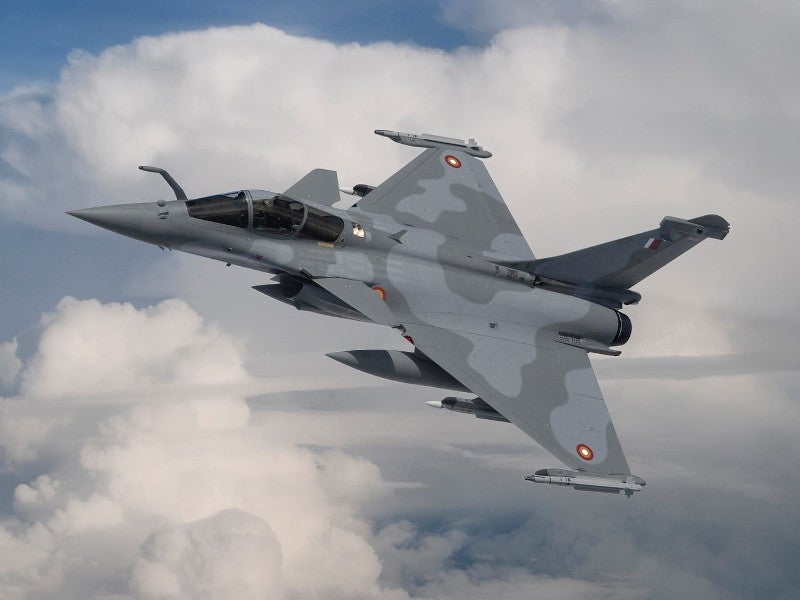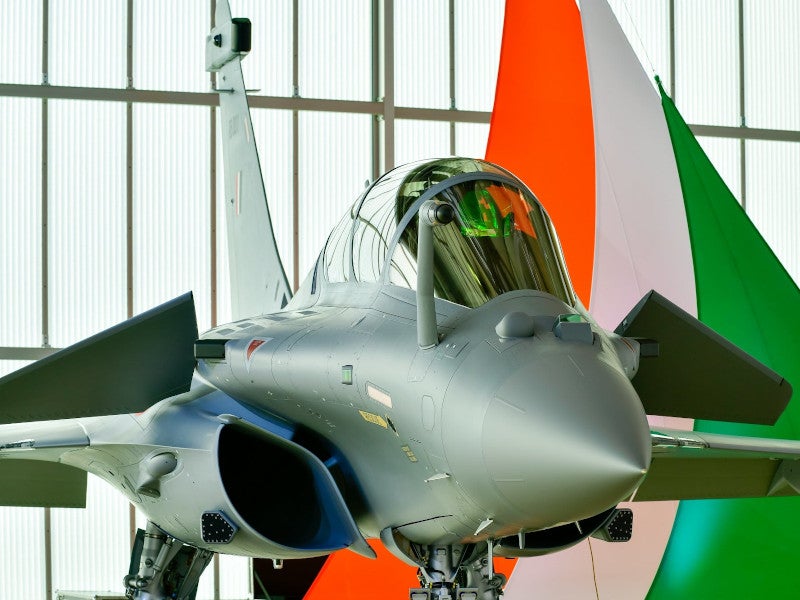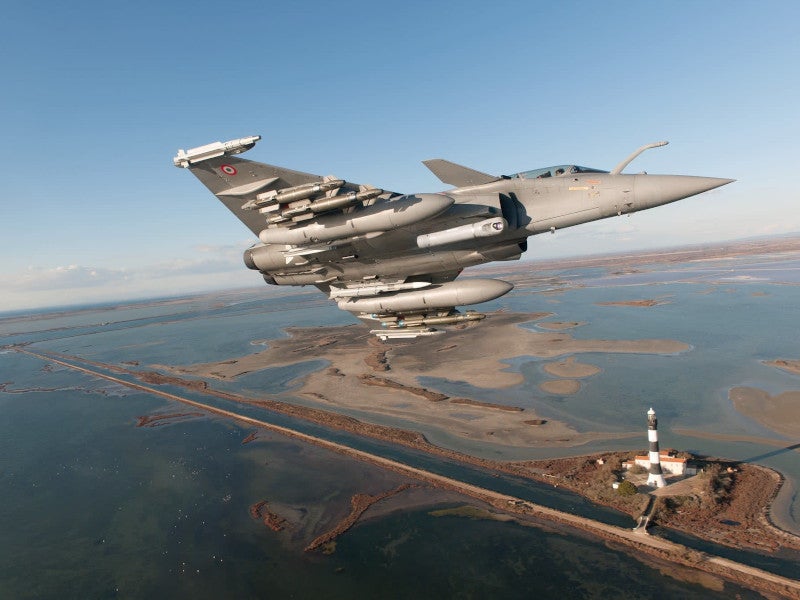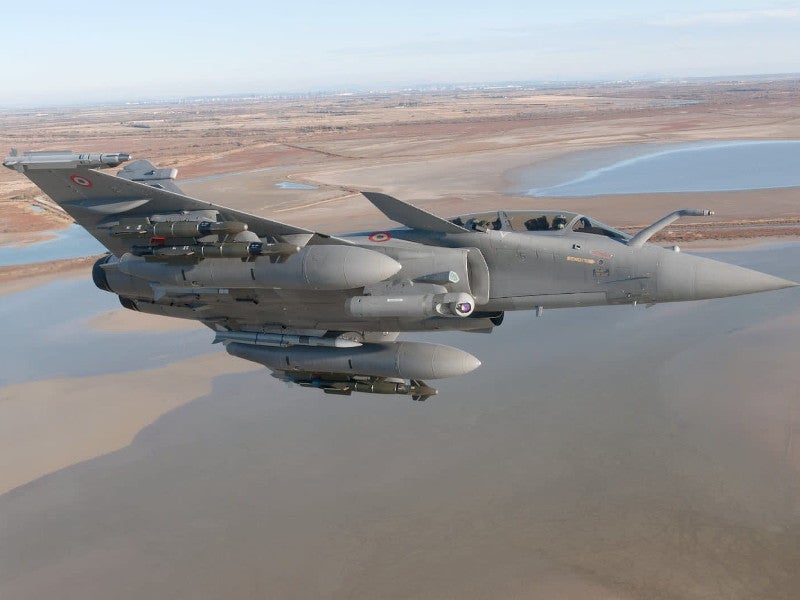Rafale is a twin-jet combat aircraft manufactured by Dassault Aviation and is capable of carrying out a wide range of short and long-range missions. It can be used to perform ground and sea attacks, reconnaissance, high-accuracy strikes and nuclear strike deterrence.
The aircraft was developed for the French Navy and French Air Force.
The fighter aircraft was used in combat operations in various nations, including Afghanistan, Mali, Libya, Syria, and Iraq. Egypt, Qatar and India also ordered the aircraft.
Rafale combat aircraft was exhibited at Langkawi International Maritime and Aerospace (LIMA) Exhibition in March 2019.
France’s airforce and navy ordered 180 (132 for the airforce and 48 for the navy) and 152 aircraft were delivered by January 2019. The manufacturer is expected to resume the delivery of the remaining 28 aircraft in 2022.
The Rafale entered service with the French Navy in 2004 and the French Air Force in 2006. Ten aircraft are operational on the Charles de Gaulle aircraft carrier.
The State of Qatar signed a contract with Dassault Aviation to acquire 24 Rafale fighters in May 2015. The $7bn contract also includes an option for 12 additional fighters and the option was exercised by Qatar in December 2017. The company started the deliveries, with the first Rafale delivered to the Qatari Emiri Air Force in February 2019.
The French defence procurement agency (DGA) qualified the Rafale F3-R standard in October 2018. The F3-R is an advanced version of Rafale F3 standard with improved versatility. In March 2017, the French Government approved the development of new advanced Rafale F4 standard.
The company received the development contract for the Rafale F4 standard aircraft in January 2019. The validation of the latest standard is expected in 2024.
Rafale fighter aircraft development
Rafale B and C entered service with the French Air Force in June 2006, when the first squadron was established. The second airforce squadron was set up in 2008. A €3.1bn ($3.89bn) contract to develop the fully capable F3 standard aircraft was awarded to Dassault Aviation (€1.5bn), Snecma (€600m), Thales (€500m) and other French contractors by the French Ministry of Defence in February 2004.
An order for 59 F3 aircraft, 47 for the airforce (11 two-seat and 36 single-seat) and 12 (single-seat) for the navy, was placed in December 2004. The Rafale F3 was certified in July 2008. The contract also includes upgrades of the Rafale F2 aircraft.
The first Rafale F3 was delivered to the French Air Force in 2008. In March 2007, three French Air Force and three navy Rafale fighters were deployed in Tajikistan in support of the Nato International Security Assistance Force (ISAF) in Afghanistan.
The French Government ordered 60 additional Rafale aircraft in November 2009. Brazil’s Government awarded a $4bn contract to Dassault Aviation in January 2010 to supply 36 Rafale multirole aircraft.
The UAE was expected to acquire the Rafale under a $10bn contract to replace its 60 ageing Mirage fighters. In November 2011, however, the deal came to a standstill when the UAE termed Dassault’s price and terms as ‘uncompetitive’. The country is also considering Eurofighter’s Typhoon to replace its ageing Mirage fighters.
In February 2012, the Indian Ministry of Defence selected Rafale for the Indian Air Force’s MMRCA (medium multirole combat aircraft) programme. The contract is worth approximately $20bn.
Rafale emerged as the preferred aircraft among various contenders for what is being called the biggest military aviation contract in the world. Its closest contender was Eurofighter’s Typhoon.
Under the contract, Dassault will supply 126 Rafale fighters. The first 18 fighters will be supplied by 2015 and the rest will be manufactured in India under a technology transfer to Hindustan Aeronautics (HAL). This contract will be the first international supply for Rafale.
The Indian Government finalised a contract in April 2015 for the acquisition of 36 (28 single-seat and eight dual-seat) Rafale aircraft. An intergovernmental deal worth €7.87bn ($8.82bn) was signed to facilitate the purchase in September 2016. France delivered the first aircraft to India in October 2019.
Dassault Aviation signed a sales contract with the Arab Republic of Egypt in February 2015 for the supply of 24 Rafale fighter aircraft. It completed the delivery of the 24th aircraft in July 2019.
Cockpit of Dassault’s Rafale Multirole Combat Fighter
The cockpit has hands-on throttle and stick control (HOTAS). The cockpit is equipped with a heads-up, wide-angle holographic display from Thales Avionique, which provides aircraft control data, mission data and firing cues.
A collimated, multi-image head-level display presents tactical situation and sensor data, while two touchscreen lateral displays show the aircraft system parameters and mission data.
The pilot also has a helmet-mounted sight and display. A CCD camera and on-board recorder records the image of the head-up display throughout the mission.
Rafale fighter weapons
Rafale can carry payloads of more than 9t on 14 hardpoints for the airforce version, with 13 for the naval version. The range of weapons includes: Mica, Magic, Sidewinder, ASRAAM and AMRAAM air-to-air missiles; Apache, AS30L, ALARM, HARM, Maverick and PGM100 air-to-ground missiles and Exocet / AM39, Penguin 3 and Harpoon anti-ship missiles.
For a strategic mission the Rafale can deliver the MBDA (formerly Aerospatiale) ASMP stand-off nuclear missile. In December 2004, the MBDA Storm Shadow / Scalp EG stand-off cruise missile was qualified on the Rafale.
In September 2005, the first flight of the MBDA Meteor BVRAAM beyond visual range air-to-air missile was conducted on a Rafale fighter. In December 2005, successful flight trials were carried out from the Charles de Gaulle of the range of Rafale’s weapon systems, Exocet, Scalp-EG, Mica, ASMP-A (to replace the ASMP) and Meteor missiles.
In April 2007, the Rafale carried out the first firing of the Sagem AASM precision-guided bomb, which has both GPS / inertial guidance and, optionally, imaging infrared terminal guidance. Rafale have been equipped with the AASM from 2008. Rafale can carry six AASM missiles, with each aiming to hit the target with 10m accuracy.
The Rafale has a twin gun pod and a Nexter (formerly Giat) 30mm DEFA 791B cannon, which can fire 2,500 rounds a minute. The Rafale is equipped with laser designation pods for laser guidance of air-to-ground missiles.
Countermeasure and sensor technology on the twin-jet combat aircraft
Rafale’s electronic warfare system is the Spectra from Thales. Spectra incorporates solid state transmitter technology, a DAL laser warning receiver, missile warning, detection systems and jammers.
The Rafale multirole combat fighter is equipped with an RBE2 passive electronically scanned radar developed by Thales, which has look-down and shoot-down capabilities. The radar can track up to eight targets simultaneously and provides threat identification and prioritisation.
Thales developed an active electronically scanned version of the RBE2, which equipped the Rafale in February 2011. Flight tests of the radar onboard the Rafale took place in 2008.
RUAG Aviation was awarded a $5m contract by Thales in May 2009 to produce sub-assemblies for the RBE2 radar to be equipped on the Rafale fighter jet.
Optronic systems include the Thales / SAGEM OSF infrared search and track system, installed in the nose of the aircraft. The optronic suite carries out search, target identification, telemetry and automatic target discrimination and tracking.
In January 2012, the French Ministry of Defence awarded a ten-year contract to Thales to maintain the electronic systems and warfare of the aircraft.
Navigation and communications of Dassault Aviation’s Rafale
The communications suite on the Rafale uses the Saturn onboard very/ultra-high frequency (V/UHF) radio, which is a second-generation, anti-jam tactical UHF radio for NATO. Saturn provides voice encryption in fast-frequency hopping mode.
The aircraft is also equipped with fixed-frequency VHF / UHF radio for communications with civil air traffic control. A multifunction information distribution system (MIDS) terminal provides secure, high-data-rate tactical data exchange with NATO C2 stations, AWACS aircraft or naval ships.
The Rafale multirole combat fighter is powered by two M88-2 engines, each providing a thrust of 75kN.
Rafale is equipped with a Thales TLS 2000 navigation receiver, which is used for the approach phase of flight. TLS 2000 integrates the instrument landing system (ILS), microwave landing system (MLS) and VHF omni-directional radio-ranger (VOR) and marker functions.
The radar altimeter is the AHV 17 altimeter from Thales, which is suitable for very low flight. The Rafale has a TACAN tactical air navigation receiver for en-route navigation and as a landing aid.
The Rafale has an SB25A combined interrogator-transponder developed by Thales. The SB25A is the first IFF using electronic scanning technology.
Rafale Multirole Combat Fighter engines
The Rafale is powered by two M88-2 engines from SNECMA, each providing a thrust of 75kN. The aircraft is equipped for buddy-buddy refuelling with a flight refuelling hose reel and drogue pack. The first M88 engine was delivered in 1996. It is a twin-shaft bypass turbofan engine principally suitable for low-altitude penetration and high-altitude interception missions.
The M88 incorporates the latest technologies such as single-piece bladed compressor disks (blisks), an on-polluting combustion chamber, single-crystal high-pressure turbine blades, powder metallurgy disks, ceramic coatings and composite materials.
The M88 engine comprises a three-stage LP compressor with inlet guide vane, an annular combustion chamber, single-stage cooled HP turbine, single-stage cooled LP turbine, radial A/B chamber, variable-section convergent flap-type nozzle and full authority digital engine control (FADEC).
Messier-Dowty provides ‘jumper’ landing gear, designed to springout when the aircraft is catapulted by the nose gear strut.





